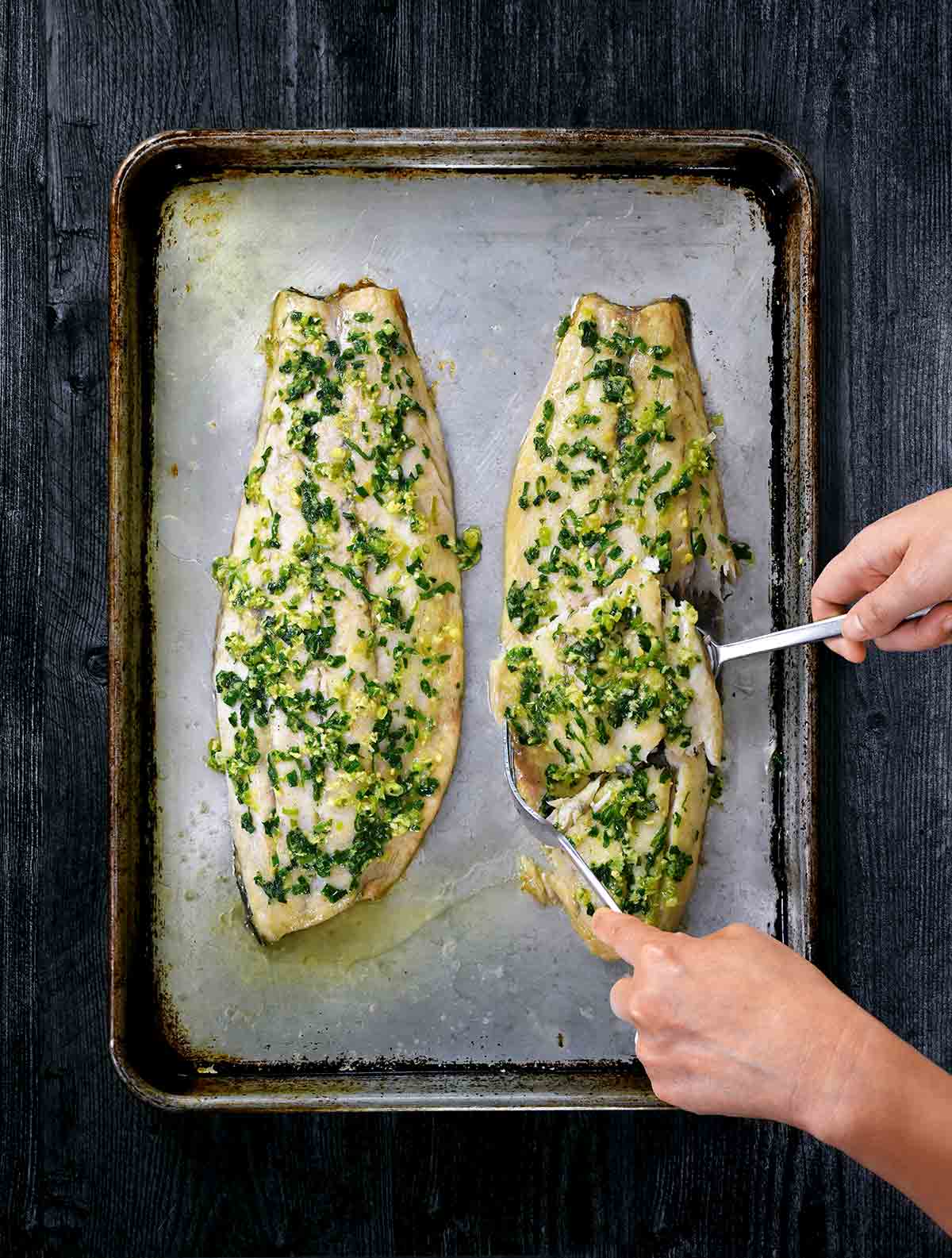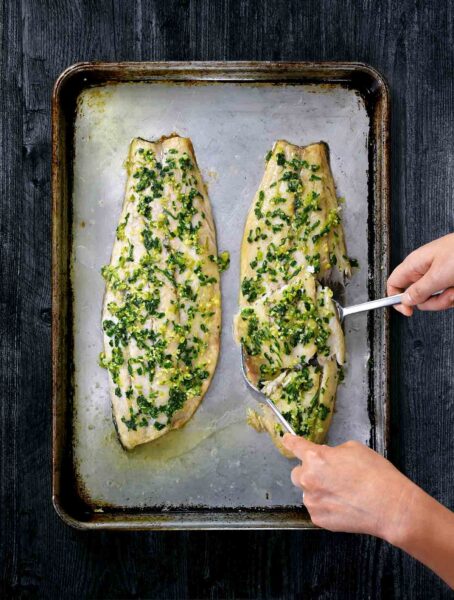
Barramundi, or Asian sea bass, is prized for its firm, moist flakes and sweet, buttery flavor. Pop some barramundi fillets under the broiler, slather them with piquant ginger-scallion sauce, and you’ll have yourself the most flavorful 30-minute supper imaginable. —Michelle Tam and Henry Fong
Want to save this?
Ginger-Scallion Fish Fillets FAQs
If you have a hard time finding barramundi, you can substitute tilapia, Icelandic cod, or halibut. Really, any firm white fish.
Our testers loved it too. Try spooning the sauce over chicken, tofu, turkey, or rice. Use it as a dip for veggies or for crusty bread. Spread it on sandwiches or mix it into egg or tuna salad.

Ginger-Scallion Fish Fillets
Ingredients
For the ginger-scallion sauce
- 1 cup (3 1/2 oz) finely minced scallions
- 3 tablespoons finely minced fresh ginger
- 2 teaspoons Diamond Crystal kosher salt (or 1 1/4 teaspoons Morton kosher salt)
- 1/4 teaspoon ground white pepper
- 1/2 cup mild vegetable oil, such as avocado or grapeseed
For the fish fillets
- Two (1-pound) Barramundi (Asian sea bass) fillets or other white fish fillets, about 1 inch (25 mm) thick
- 1 teaspoon Diamond Crystal kosher salt (or 3/4 teaspoon Morton kosher salt)
- 1/4 teaspoon ground white pepper
- 2 tablespoons mild vegetable oil, such as avocado or grapeseed
Instructions
Make the ginger-scallion sauce
- Toss the scallions, ginger, salt, and white pepper into a large heatproof bowl or 2 cup (480 ml) glass measuring cup. Stir together.
- In a small saucepan over high heat, warm the oil until it’s shimmering but not quite smoking.
- Add a tiny piece of scallion to test the heat of the oil. If you see lots of little bubbles, the oil’s ready. (Or just check that the oil reaches 375°F (190°C) on an instant-read thermometer.)
- Pour the hot oil into the scallion and ginger mixture a little at a time. It’ll sizzle and boil, so be careful!
- Stir well, then let the sauce cool to room temperature. The sauce can be refrigerated in a sealed jar for up to 2 weeks or frozen in an ice cube tray for up to 3 months.
Make the fish fillets
- Turn on broiler. Position top rack 6 inches (15 cm) away from the heating element.
- Use paper towels to pat the fish fillets dry. Season the top and bottom with salt and white pepper.
- Pour the oil on a rimmed baking sheet, and rub or brush the oil on all sides of the fillets.
- Arrange the fish skin-side down on the baking sheet.
- Place the fillets under the broiler and cook until the fish reaches 140°F (60°C), 8 to 12 minutes. Use a fork to check that the thickest parts are opaque and flake apart easily.
- Remove the fish from the oven and generously spoon the ginger-scallion sauce over the fish. Serve it up!

Explore More with AI
Nutrition
Nutrition information is automatically calculated, so should only be used as an approximation.
Recipe Testers’ Reviews
Easy and delicious, the ginger-scallion sauce will dress up any light protein. I couldn’t find Barramundi, so I used tilapia instead. Broiling tilapia was also a revelation–I’ve never had much success sautéing it (sticking and breaking apart), so this will become my new go-to technique. I served this with broccolini with tahini sauce and a side salad.
I am a big fan of scallions, so it was a given that I’d try these ginger-scallion fish fillets. I can see this becoming part of the regular dinner rotation! It’s a quick, easy, and very delicious meal. I loved the ginger-scallion sauce–the scallions become mellow and sweet, the ginger is pungent, it’s just this side of too salty (which is a positive because I often find white fish to be a bit bland). I’m glad that the recipe makes more than needed for the fish because I fully intend to use it on most of what I cook for the next several days!
This makes 4 generous to 6 smaller servings, depending on how much is being served alongside the fish. I served it with rice and some roasted broccoli (covered in extra ginger-scallion sauce!)
Wow, this is such a flavourful dish, yet requires such little preparation and so few ingredients. Don’t let trying to find Barramundi put you off–this works well with any firm white fish (I used Icelandic cod and it was perfect). I’d suggest you might want to use more of the ginger-scallion “sauce” than the recipe calls for (it’s more like a dressing) and for an extra burst of flavour, try sesame oil on the fish – works well with the ginger-scallion flavours. This was perfect served with steamed white rice and some sautéed bok choy.
The fish itself is pretty standard broiled fish. Seasoned with just salt and pepper, it’s not anything special. However, the ginger-scallion sauce takes it to another level. Be generous with the amount you put on the fish to serve. It is so easy to make, and the flavor is fantastic. The only change I would make is to add less salt as it was a little too salty. Don’t pass up this recipe even if you do not eat fish–make the sauce and use it on chicken or even as a dipping sauce with crusty bread. The leftover sauce is even more flavorful.
I took advantage of the last of the season halibut for these ginger-scallion fish fillets. The ginger-scallion sauce was the perfect foil for the mild-flavored halibut. I really take note when recipes call for white pepper, I think it is an under-utilized ingredient. It has a bit of heat, but also a lovely floral note whenever it is used.
We slathered the ginger-scallion sauce on the fish, couldn’t get enough of it. And we also made sure the sauce found its way over to the black rice and Brussels sprouts we served it with. Such a beautiful plating, white, green and black.
This is a great quick weeknight dinner. There was a bit of leftover sauce, which we used up for lunch the next day with leftover rice.
Exactly as promised, this recipe delivers a flavorful and perfectly-cooked fish dish. Using good quality fish fillets is essential. My local Whole Foods does not carry frozen Barramundi, so I used fresh triple tail from my local seafood market which proved to be an excellent alternative. The ginger-scallion sauce adds great flavor to the broiled fillets and makes then quite visually appealing. A very quick meal for a weeknight or a special weekend dinner.
The ginger-scallion sauce is simple and super tasty and works so well with the almost meaty fillets of barramundi. Next time I’d pan fry my fillets, simply to give the skin a crisp texture, because the grilling leaves the skin soft and rubbery, which for me was not something I wanted to eat. I made half the quantity of the sauce, which was perfect for the 4 fillets of fish.
We had our fillets with leftover roasted sweet potato which I mashed and served under the fish to soak in some extra sauce, as well as a leafy salad with cucumber, roasted broccoli, radish, and a sesame/lime dressing. It was a really good match.
While this ginger-scallion fish fillets recipe may seem like a fish recipe, the real recipe is the ginger-scallion sauce. The combination of these two ingredients creates an extremely flavorful and aromatic sauce that I highly recommend trying if you haven’t before. The classic pairing is with chicken and the use of fish in this recipe demonstrates the versatility of this sauce. It is easy to prepare as is the recipe as a whole. This dish is fast to make, and even faster if the sauce is already made. This is one of those recipes where very little effort produces great results.
This is one of the easiest weeknight dinners one for ask for: make sauce, broil fish, top with sauce. If ginger-scallion sauce already has a permanent home in your fridge, then it’s only a two-step recipe. The fish was delicate and flakey, and the sauce provided great flavor without interfering with our ability to taste the fish. Even making the sauce fresh, you can get this together in 20 minutes. If you already have ginger-scallion sauce in the fridge, I’d recommend portioning out the 1/4 cup needed and warming that up in the microwave or on the stovetop before spooning it over the fish. Use the leftover sauce for poached chicken, roasted vegetables, plain rice, or for a really stand-out fried rice.
















Interesting there is no soy sauce in use, this looks good and will try it. How about black cod (sablefish, butterfish)?
lowandslow, I think it would work beautifully on black cod. The sauce is very versatile and certainly pairs well with any firm white fish.